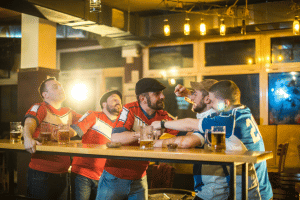When new team members put together there can be friction. The established order could feel unhappy with the new faces or a merger between to rival companies can leave staff that used to compete against each other, now needing to work together. Behavioural science can offer a tactful way to put rivals together more successfully.
Research involving soccer fans proves helpful for better team integration
Professor Mark Levine of Lancaster University, conducted research into how supporters of a passionate soccer club could be made to react less negative to supporters of a rival club. Supporters of the Manchester United soccer club were asked to participate in this social psychology experiment. They came to the university campus and were asked to fill out a questionnaire about why they liked their soccer team.

They were then asked to walk to another building on the campus for the second part of the test, but things were set up so that they would witness a jogger falling near them as they walked to the other building. The jogger would have a staged accident and wear different T-shirt per group of Manchester United fans. The question was, how many of the supporters would lend assistance to the jogger when he wore:
- A neutral T-shirt
- A Manchester United T-shirt
- A Liverpool T-shirt (the big rival club to Manchester United)
How many soccer supporters assisted the jogger in the rival club t-shirt?
When the jogger in this social psychology experiment was wearing the neutral shirt, about one third of Manchester United supporters assisted him when he injured himself. When he was wearing the Manchester United shirt, nearly ALL of Manchester United supporters assisted him when he injured himself. Somewhat expected, then the jogger was wearing the rival club ‘Liverpool’ T-shirt, very few of Manchester United supporters assisted him when he injured himself.
Focussing on commonalities between rivals can strengthen relationships

For a second group of supporters, the questionnaire did not focus on the club they were supporting, but rather asked what they liked about being soccer supporters. They were then also asked to walk to the other building and each group was confronted by the different t-shirt of the jogger hurting himself.
TWICE AS MANY supporters of the Manchester United club assisted the fallen jogger in a Liverpool shirt when they had being focusing on the love of sport rather than the love of their own club.
How to encourage cooperation between opposing people or teams
When we have people of teams that need to work together and there is friction between them, it is important to focus on things/interests that they share. Managers should place emphasis on what things they have in common and take focus away from what divides them.
Optimising conditions for improving cooperation between rival parties
Adam Grant who is a professor at Wharton School of Business, suggests in his book that when focusing on commonalities, it is more effective to focus on ‘uncommon commonalities’. These are commonalities that the parties share but they don’t share with many others.
Whilst they may have in common that they drive to work and eat lunch every day, this doesn’t seem to make them feel like a special group as we tend to have that in common with many people. Instead, a specific passion for a type of sport, type of trade, interest in what the company does… can be far more exclusive and therefor uncommon.
The Principle of Unity and groups
Dr Cialdini and us teach about a Principle of Influence called UNITY. It has to do with how people identify as being part of a group. A feeling of ‘we-ness’ so to speak. Examples of groups people could feel to belong to
- Being a supporter of a specific sports club
- Being a member of an organisation
- Being a recident of a specific town or city
- Being a citizen of country
- Being a past student of a particular school
- Being a devotee of a religion
- Being a supported of the political party
There are many more possibilities for groups people can feel part of. By bringing attention to this, we can build a better relationship with people. For example, when you see a photo of your boss on a sail boat in his office, and you genuinely also sail, have sailed, might have your own boat, might have sailed with your family… then you could bring up the sailing in conversation and ask what is behind the photo. Once responded to, you tell why you asked and tell about your connection to sailing. You’ll likely both be smiling and very quickly you both now feel that you are both part of the group ‘sailing enthusiasts’. When now you propose you idea that brought you into the office, you are likely going to find more cooperation than if you hadn’t genuinely brought focus to what makes you similar.

As this article highlights, the UNITY with an opposing group can then be a cause for resistance, so we don’t want to draw attention to that difference. As a detective of Influence, you want to look for the group identification that will bring power to your desired cooperation.
